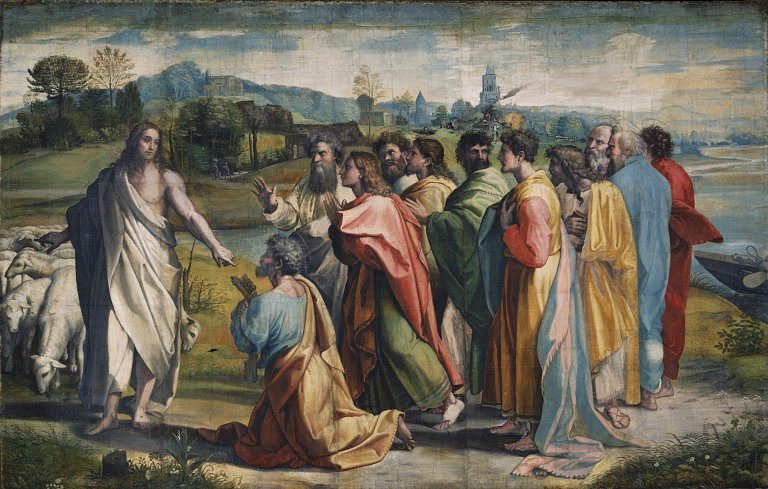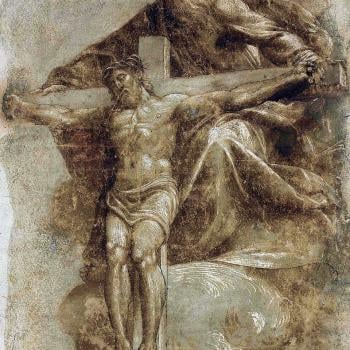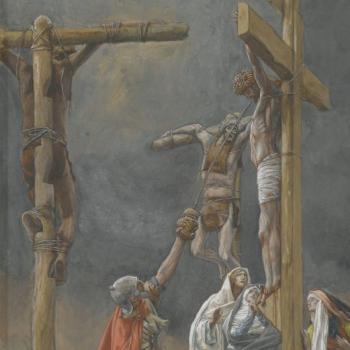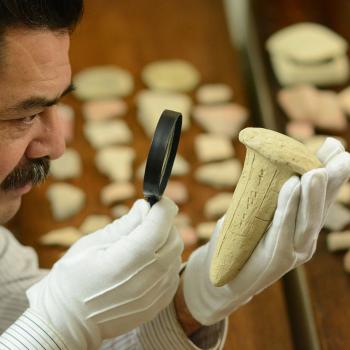
If Jesus had not risen from the dead, we can expect that his disciples would have chosen one of two options. According to N.T. Wright, the “normal options open” to the disciples following Jesus’ demise were: they could have chosen to go back to fishing and other former occupations, or they could have chosen a replacement as messiah from among Jesus’ blood relatives, like James.[1] As the story goes, they did not choose either option. Instead, according to the New Testament witness, following the resurrection, their faith in Jesus underwent resuscitation.
Take Peter, for example. It looks as if he was already leaning toward the first of the two options Wright presents—Peter went fishing, just like he used to do. He’s not alone. Some of the other disciples joined him. Here’s the account of their fishing expedition recorded in John 21:
After this Jesus revealed himself again to the disciples by the Sea of Tiberias, and he revealed himself in this way. Simon Peter, Thomas (called the Twin), Nathanael of Cana in Galilee, the sons of Zebedee, and two others of his disciples were together. Simon Peter said to them, “I am going fishing.” They said to him, “We will go with you.” They went out and got into the boat, but that night they caught nothing (John 21:1-3; ESV).
The account sounds strikingly familiar. Earlier in the gospels, Peter and his companions were out fishing all night long but caught nothing (See Luke 5:1-11). Moreover, in both instances (Luke’s and John’s accounts), Jesus tells them to throw out their nets again. They did not recognize Jesus at first in the account recorded in John 21, not until they cast their nets and haul in an unbelievably large load, just like in the earlier incident:
Just as day was breaking, Jesus stood on the shore; yet the disciples did not know that it was Jesus. Jesus said to them, “Children, do you have any fish?” They answered him, “No.” He said to them, “Cast the net on the right side of the boat, and you will find some.” So they cast it, and now they were not able to haul it in, because of the quantity of fish. That disciple whom Jesus loved therefore said to Peter, “It is the Lord!” When Simon Peter heard that it was the Lord, he put on his outer garment, for he was stripped for work, and threw himself into the sea. The other disciples came in the boat, dragging the net full of fish, for they were not far from the land, but about a hundred yards off (John 21:4-8; ESV).
In John 21, we find that Jesus prepared a campfire meal of fish and bread for them (See John 21:9-13). The paragraph about the meal ends with the narrator stating: “This was now the third time that Jesus was revealed to the disciples after he was raised from the dead” (John 21:14; ESV).
As with the earlier accounts, we find a bit of faith resuscitation going on. In John 20, we find that Jesus appeared to the Apostles on two separate occasions (after having first appeared to Mary Magdalene). In each instance, the disciples had locked themselves up in a room (John 20:19, 26). Here in John 21, they seem to have had enough courage to venture out to go fishing. Based on the prior two resurrection appearances, the disciples were now fully cognizant of Jesus’ resurrection. Yet, it did not keep them from going fishing. In fact, in Peter’s case, it was likely that he would return to fishing as an occupation, even though he knew Jesus had been raised.
Why do I think Peter would return to fishing as an occupation? Because he had denied Jesus three times. Peter probably thought that his days of fishing for people as a witness to Jesus (Luke 5:10) were over because of his colossal failure of faith in denying Jesus three times. But Jesus has a way of meeting people where they are and leading them to where he wants them to be. In Luke 5 and in John 21 respectively, Peter appeared to acknowledge that he is not worthy of Jesus. In Luke 5:8, we find Peter crying out, “Depart from me, for I am a sinful man, O Lord” (Luke 5:8; ESV). In John 21, Peter was cut to the heart with grief when Jesus asked him a third time (the same number as his denials) if Peter loved Jesus. While in Luke 5, Peter was told once that he would fish for people, here in John 21, Peter was exhorted three times to feed Jesus’ sheep. Peter had denied Jesus three times, but Jesus in turn asked Pete three times if he loves Jesus, and then reaffirmed Peter three times by telling him to get back to following Jesus, not comparing himself with others, and to care for God’s flock. Here’s the recommissioning, which involved the resuscitation of Peter’s faith:
When they had finished breakfast, Jesus said to Simon Peter, “Simon, son of John, do you love me more than these?” He said to him, “Yes, Lord; you know that I love you.” He said to him, “Feed my lambs.” He said to him a second time, “Simon, son of John, do you love me?” He said to him, “Yes, Lord; you know that I love you.” He said to him, “Tend my sheep.” He said to him the third time, “Simon, son of John, do you love me?” Peter was grieved because he said to him the third time, “Do you love me?” and he said to him, “Lord, you know everything; you know that I love you.” Jesus said to him, “Feed my sheep. Truly, truly, I say to you, when you were young, you used to dress yourself and walk wherever you wanted, but when you are old, you will stretch out your hands, and another will dress you and carry you where you do not want to go.” (This he said to show by what kind of death he was to glorify God.) And after saying this he said to him, “Follow me” (John 21:15-19; ESV).
Perhaps you can relate to Peter. You may firmly believe in the resurrection of Jesus, but you have no confidence that you can go through a resuscitation of your faith as an active follower of Jesus because of failures in your life and ministry. Each of us should realize that we are not worthy of Jesus–not even when we are at our best. But we should also realize that if Jesus who alone is worthy tells us to get back up and follow him, who are we to resist?
I asked my wife why she thought Jesus delayed his ascent to his Father’s throne for forty days. Her response: so she could teach the baby birds to fly. Indeed, Jesus wanted these little birds, or “children” as he refers to them in John 21:5, to get back up and follow him and lead his people.
Jesus was not resuscitated, but rather resurrected. However, in the case of his followers, Jesus appeared to his disciples over a forty-day period after his resurrection to bring about the resuscitation of their faith and reignite their witness. So, too, he makes himself known to us today, not just until his ascension (which we celebrate forty days after Easter), but throughout the church year. We should encourage one another–just as Jesus exhorted Peter–in the midst of our doubts about ourselves not to give up, but to undergo a resuscitation of faith. Get back up with rejuvenated faith in view of Jesus’ call and get to work. Feed his sheep.
_______________
[1]N.T. Wright, “Christian Origins and the Resurrection of Jesus: The Resurrection of Jesus as a Historical Problem,” in Sewanee Theological Review, 41.2, 1998, reproduced by permission of the author at http://ntwrightpage.com/2016/07/12/christian-origins-and-the-resurrection-of-jesus-the-resurrection-of-jesus-as-a-historical-problem/ (accessed on 4/21/2019).












